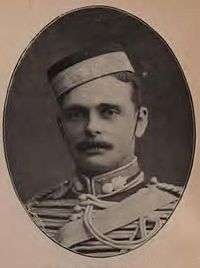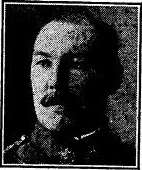Woodbridge (UK Parliament constituency)
| Woodbridge | |
|---|---|
|
Former County constituency for the House of Commons | |
| County | Suffolk |
| Major settlements | Woodbridge |
| 1885–1950 | |
| Number of members | One |
| Replaced by | Sudbury & Woodbridge |
| Created from | East Suffolk |
Woodbridge was a county constituency centred on the town of Woodbridge in Suffolk. It returned one Member of Parliament (MP) to the House of Commons of the Parliament of the United Kingdom.
The constituency was created for the 1885 general election, and abolished for the 1950 general election. It was then largely replaced by the new Sudbury & Woodbridge constituency.
Boundaries
1885-1918: The Municipal Borough of Woodbridge, the Sessional Divisions of Bosmere and Claydon, Samford, and Woodbridge, and the Corporate Town of Aldeburgh.
1918-1950: The Municipal Borough of Aldeburgh, the Urban Districts of Felixstowe and Woodbridge, the Rural Districts of Bosrnere and Claydon, Samford, and Woodbridge, and part of the Rural District of Plomesgate.
Members of Parliament
Elections
Elections in the 1880s
| Party | Candidate | Votes | % | ± | |
|---|---|---|---|---|---|
| Liberal | Robert Lacey Everett | 4,978 | n/a | ||
| Conservative | Lord Bendlesham | 4,810 | n/a | ||
| Majority | 168 | n/a | |||
| Turnout | n/a | ||||
| Liberal win (new seat) | |||||
| Party | Candidate | Votes | % | ± | |
|---|---|---|---|---|---|
| Conservative | Robert Hamilton Lloyd-Anstruther | 4,854 | |||
| Liberal | Robert Lacey Everett | 4,541 | |||
| Majority | 313 | ||||
| Turnout | |||||
| Conservative gain from Liberal | Swing | ||||
Elections in the 1890s
| Party | Candidate | Votes | % | ± | |
|---|---|---|---|---|---|
| Liberal | Robert Lacey Everett | 5,223 | |||
| Conservative | Robert Hamilton Lloyd-Anstruther | 4,485 | |||
| Majority | 738 | ||||
| Turnout | |||||
| Liberal gain from Conservative | Swing | ||||

| Party | Candidate | Votes | % | ± | |
|---|---|---|---|---|---|
| Conservative | Ernest George Pretyman | 5,410 | |||
| Liberal | Robert Lacey Everett | 4,778 | |||
| Majority | 632 | ||||
| Turnout | |||||
| Conservative gain from Liberal | Swing | ||||
Elections in the 1900s
| Party | Candidate | Votes | % | ± | |
|---|---|---|---|---|---|
| Conservative | Ernest George Pretyman | 5,089 | |||
| Liberal | Robert Lacey Everett | 4,437 | |||
| Majority | 652 | ||||
| Turnout | |||||
| Conservative hold | Swing | ||||

| Party | Candidate | Votes | % | ± | |
|---|---|---|---|---|---|
| Liberal | Robert Lacey Everett | 5,527 | 50.8 | ||
| Conservative | Ernest George Pretyman | 5,348 | 49.2 | ||
| Majority | 179 | 1.6 | |||
| Turnout | |||||
| Liberal gain from Conservative | Swing | ||||
Elections in the 1910s
| Party | Candidate | Votes | % | ± | |
|---|---|---|---|---|---|
| Conservative | Robert Francis Peel | 6,120 | |||
| Liberal | Charles Sydney Buxton | 5,226 | |||
| Majority | |||||
| Turnout | |||||
| Conservative gain from Liberal | Swing | ||||
| Party | Candidate | Votes | % | ± | |
|---|---|---|---|---|---|
| Conservative | Robert Francis Peel | 5,704 | 52.6 | ||
| Liberal | William Rowley Elliston | 5,144 | 47.4 | ||
| Majority | 5.2 | ||||
| Turnout | |||||
| Conservative hold | Swing | ||||
General Election 1914/15:
Another General Election was required to take place before the end of 1915. The political parties had been making preparations for an election to take place and by the July 1914, the following candidates had been selected;
- Unionist: Robert Francis Peel
- Liberal: William Rowley Elliston

| Party | Candidate | Votes | % | ± | |
|---|---|---|---|---|---|
| Unionist | 8,654 | 55.8 | |||
| Liberal | Maj. William Rowley Elliston | 6,842 | 44.2 | ||
| Majority | 1,812 | 11.6 | |||
| Turnout | 51.0 | ||||
| Unionist hold | Swing | ||||
- endorsed by the Coalition Government
Elections in the 1920s
| Party | Candidate | Votes | % | ± | |
|---|---|---|---|---|---|
| Unionist | Sir Arthur Charles Churchman | 9,898 | 53.2 | -2.6 | |
| Labour | Henry Devenish Harben | 8,707 | 46.8 | n/a | |
| Majority | 1,191 | 6.4 | |||
| Turnout | 61.4 | +10.4 | |||
| Unionist hold | Swing | ||||
| Party | Candidate | Votes | % | ± | |
|---|---|---|---|---|---|
| Unionist | Sir Arthur Charles Churchman | 12,396 | 56.7 | +3.5 | |
| Labour | Edward John Cecil Neep | 9,476 | 43.3 | -3.5 | |
| Majority | 2,920 | 13.4 | +6.8 | ||
| Turnout | 69.1 | +7.7 | |||
| Unionist hold | Swing | +3.4 | |||
| Party | Candidate | Votes | % | ± | |
|---|---|---|---|---|---|
| Unionist | Sir Arthur Charles Churchman | 10,606 | 46.7 | -10.0 | |
| Liberal | William Rowley Elliston | 7,328 | 32.2 | n/a | |
| Labour | Edward John Cecil Neep | 4,810 | 21.1 | -22.2 | |
| Majority | 3,278 | 14.5 | +1.1 | ||
| Turnout | 70.9 | +1.8 | |||
| Unionist hold | Swing | n/a | |||
| Party | Candidate | Votes | % | ± | |
|---|---|---|---|---|---|
| Unionist | Sir Arthur Charles Churchman | 13,419 | 54.9 | +8.2 | |
| Liberal | William Rowley Elliston | 7,008 | 28.7 | -3.5 | |
| Labour | Sylvain Mayer | 3,998 | 16.4 | -4.7 | |
| Majority | 6,411 | 26.2 | +11.7 | ||
| Turnout | 74.3 | +3.4 | |||
| Unionist hold | Swing | +5.8 | |||
| Party | Candidate | Votes | % | ± | |
|---|---|---|---|---|---|
| Unionist | Frank Guy Clavering Fison | 15,231 | 48.1 | -6.8 | |
| Liberal | Roger Thomas Baldwin Fulford | 10,904 | 34.5 | +5.8 | |
| Labour | Leonard Spero | 5,507 | 17.4 | +1.0 | |
| Majority | 4,327 | 13.6 | -12.6 | ||
| Turnout | 73.3 | -1.0 | |||
| Unionist hold | Swing | -6.3 | |||
Elections in the 1930s
| Party | Candidate | Votes | % | ± | |
|---|---|---|---|---|---|
| Conservative | Walter Ross-Taylor | 25,654 | 81.3 | +33.2 | |
| Labour | Ida Mary Nussey Keeble | 5,885 | 18.7 | +1.3 | |
| Majority | 19,769 | 62.6 | +49.0 | ||
| Turnout | 70.6 | -2.7 | |||
| Conservative hold | Swing | n/a | |||
| Party | Candidate | Votes | % | ± | |
|---|---|---|---|---|---|
| Conservative | Walter Ross-Taylor | 22,715 | 72.1 | -9.2 | |
| Labour | A V Smith | 8,808 | 27.9 | +9.2 | |
| Majority | 13,907 | 44.2 | -18.4 | ||
| Turnout | 67.5 | +4.9 | |||
| Conservative hold | Swing | -9.2 | |||
General Election 1939/40:
Another General Election was required to take place before the end of 1940. The political parties had been making preparations for an election to take place and by the Autumn of 1939, the following candidates had been selected;
- Conservative: Hon. John Hugh Hare
- Liberal: Douglas B Law[17]
- Labour: J M Stewart[18]
Elections in the 1940s
| Party | Candidate | Votes | % | ± | |
|---|---|---|---|---|---|
| Conservative | Lt-Col. Hon. John Hugh Hare | 16,073 | 47.0 | -25.1 | |
| Labour | J M Stewart | 11,380 | 33.3 | +5.4 | |
| Liberal | Capt. Douglas B Law | 6,740 | 19.7 | n/a | |
| Majority | |||||
| Turnout | 71.4 | ||||
| Conservative hold | Swing | ||||
Sources
- ↑ The Liberal Year Book, 1907
- ↑ The Liberal Year Book, 1907
- ↑ The Liberal Year Book, 1907
- ↑ Debrett's House of Commons and the Judicial Bench, 1901
- ↑ Debrett's House of Commons and the Judicial Bench, 1901
- ↑ British parliamentary election results, 1885-1918 (Craig)
- ↑ Debrett's House of Commons and the Judicial Bench, 1916
- ↑ Debrett's House of Commons and the Judicial Bench, 1916
- ↑ British Parliamentary Election Results 1918-1949, FWS Craig
- ↑ British Parliamentary Election Results 1918-1949, FWS Craig
- ↑ British Parliamentary Election Results 1918-1949, FWS Craig
- ↑ British Parliamentary Election Results 1918-1949, FWS Craig
- ↑ British Parliamentary Election Results 1918-1949, FWS Craig
- ↑ British Parliamentary Election Results 1918-1949, FWS Craig
- ↑ British Parliamentary Election Results 1918-1949, FWS Craig
- ↑ British Parliamentary Election Results 1918-1949, FWS Craig
- ↑ The Liberal Magazine, 1939
- ↑ Report of the Annual Conference of the Labour Party, 1939
- ↑ British Parliamentary Election Results 1918-1949, FWS Craig
- Leigh Rayment's Historical List of MPs – Constituencies beginning with "W" (part 5)
- Craig, F. W. S. (1989) [1974]. British parliamentary election results 1885–1918 (2nd ed.). Chichester: Parliamentary Research Services. p. 395. ISBN 0-900178-27-2.
- Craig, F. W. S. (1983) [1969]. British parliamentary election results 1918–1949 (3rd ed.). Chichester: Parliamentary Research Services. p. 469. ISBN 0-900178-06-X.